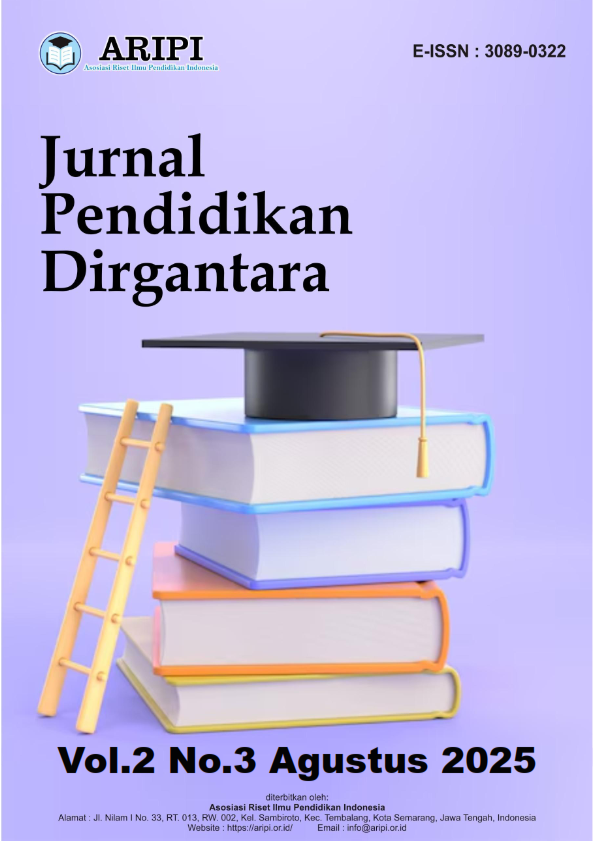Penerapan Model Pembelajaran Kooperatif Tipe Jigsaw untuk Meningkatkan Pemahaman Materi Tembang Macapat di Kelas IV Sekolah Dasar
DOI:
https://doi.org/10.61132/jupendir.v2i3.602Keywords:
Jigsaw model, macapat song, cooperative learning, student understanding, local cultureAbstract
This study aims to improve the understanding of macapat songs by applying the Jigsaw cooperative learning approach. Although macapat songs have high moral and intellectual values, students often dislike them because they are considered complex and irrelevant. This study used the McTaggart model consisting of two cycles, combined with the Classroom Action Research (CAR) method. Data were collected through various techniques, including observation, tests, interviews, and note-taking, and then analyzed qualitatively and quantitatively. The results showed that students' understanding of the meaning of macapat songs increased significantly when the Jigsaw model was applied. The learning completion rate increased from 56% to 100%, while the average student score also increased from 72.33 in the pre-cycle to 86.6 in the first cycle. These findings demonstrate the effectiveness of the Jigsaw approach in improving student understanding. In addition, this method also succeeded in encouraging active student participation, increasing their confidence in class discussions, and fostering respect for the rich local culture. Thus, teaching local Javanese language through the Jigsaw cooperative learning paradigm can be considered an interesting and effective alternative approach. This approach not only helps students understand the material better but also strengthens their social and cultural skills. This research provides an important contribution to the development of more innovative and relevant teaching methods in the context of regional language learning, and encourages teachers to implement strategies that can increase students' interest and understanding of the valuable and diverse local culture. Through the application of this method, it is hoped that students will gain a greater appreciation for their cultural heritage.
References
Akhmad, M., & Dewi, I. R. (2022). Penerapan model pembelajaran Jigsaw untuk meningkatkan pemahaman siswa pada mata pelajaran seni budaya. Jurnal Pendidikan Humaniora, 10(1), 45–53.
Azizah, K. U., & Desyandri, D. (2020). Penerapan Model Pembelajaran Kooperatif Tipe Jigsaw untuk Meningkatkan Hasil Belajar Siswa pada Pembelajaran Tematik Terpadu di Sekolah Dasar. Jurnal Pendidikan Tambusai, 4(3), 2585–2595. https://doi.org/10.24036/jippsd.v3i2.107576
Haidar, Z. (2018). MACAPAT: Tembang Jawa Indah dan Kaya Makna. Jakarta Timur: Badan Pengembangan dan Pembinaan Bahasa.
Huda, M. (2015). Model-Model Pengajaran dan Pembelajaran: Isu-isu Metodis dan Paradigmatis. Yogyakarta: Pustaka Pelajar.
Lie, A. (2020). Cooperative Learning: Teori dan Aplikasi. Jakarta: Grasindo.
Lubis, A. R., & Harahap, S. R. (2016). Penerapan model pembelajaran kooperatif tipe Jigsaw untuk meningkatkan hasil belajar siswa. Jurnal As-Salam, 1(1), 1–10. https://jurnal-assalam.org/index.php/JAS/article/view/48
Nini, S., & Bey, H. L. (2020). Pengaruh model pembelajaran kooperatif tipe Jigsaw terhadap kemampuan komunikasi matematis siswa. Jurnal Penelitian Pendidikan Matematika, 8(2), 143–152.
Nugroho, B. S., & Kartowagiran, B. (2019). Implementasi model pembelajaran kooperatif tipe Jigsaw untuk meningkatkan hasil belajar. Jurnal Inovasi Pendidikan, 6(2), 125–136.
Nuryani, T., & Efendi, A. (2020). Metode Pengajaran Bertahap untuk PengajaranTembang Macapat. Yogyakarta: BILDUNG.
Ratnasari, A., & Adiwijaya, A. (2021). Nilai karakter dalam tembang macapat sebagai pengayaan peserta didik sekolah dasar. Elementary: Jurnal Ilmiah Pendidikan Dasar, 7(1), 107–118.
Santosa, H. (2018). Internalisasi nilai-nilai pendidikan karakter dalam tembang macapat pada pembelajaran muatan lokal Bahasa Jawa di sekolah dasar. Al-Bidayah: Jurnal Pendidikan Dasar Islam, 10(1), 65–78.
Satori, D., & Komariah, A. (2010). Metodologi Penelitian Kualitatif (Cet. ke-2). Bandung: Alfabeta.
Sianturi, R. (2017). Penerapan model pembelajaran kooperatif tipe Jigsaw untuk meningkatkan aktivitas dan hasil belajar siswa pada materi dunia tumbuhan. Jurnal Bioterdidik: Wahana Ekspresi Ilmiah, 5(2), 1–8.
Sugiyanto, & Rahmawati, L. (2021). Penerapan teori Vygotsky dalam pembelajaran berbasis sosial. Jurnal Pendidikan dan Pembelajaran, 28(3), 234–242.
Sulistia, D. A., Nurhidayati, H., Sari, D. A. K., Segara, N. B., & Ningrawati, T. (2024). Penerapan Model Pembelajaran Kooperatif Tipe Jigsaw untuk Meningkatkan Kolaborasi Peserta Didik pada Mata Pelajaran IPS.
Susanti, R., Herawati, D., & Ardiansyah, D. (2020). Efektivitas model pembelajaran kooperatif tipe Jigsaw terhadap motivasi belajar siswa sekolah dasar. Jurnal Pendidikan Dasar, 8(2), 89–96.
Syaputri, R., & Eliyasni, R. (2020). Penerapan Model Pembelajaran Kooperatif Tipe Jigsaw untuk Meningkatkan Hasil Belajar Tematik Terpadu Kelas IV Sekolah Dasar. Jurnal Pendidikan Tambusai, 4(3), 2350–2358. https://doi.org/10.31004/jptam.v4i3.689
Ulfa, M. (2018). Pengaruh model pembelajaran kooperatif tipe Jigsaw terhadap keterampilan komunikasi lisan dan hasil belajar kognitif siswa pada pembelajaran biologi. Bioedukasi: Jurnal Pendidikan Biologi, 11(1), 56–64.
Umar, A., & Kaco, N. (2008). Penelitian Tindakan Kelas. Makassar: Badan Penerbit Universitas Negeri Makassar.
Wahyuni, D. (2024). Penerapan Model Pembelajaran Jigsaw untuk Meningkatkan Kerjasama dan Prestasi Belajar. Diadik: Jurnal Ilmiah Teknologi Pendidikan, 14(2), 343–351.
Warsono, & Hariyanto. (2014). Pembelajaran Aktif: Teori dan Asesmen. Bandung: Remaja Rosdakarya.
Yusuf, M. (2020). Pengaruh model pembelajaran kooperatif tipe Jigsaw terhadap hasil belajar siswa pada mata pelajaran TIK. Media Komunikasi Pendidikan Teknologi dan Kejuruan, 10(1), 31–39.
Downloads
Published
How to Cite
Issue
Section
License
Copyright (c) 2025 Jurnal Pendidikan Dirgantara

This work is licensed under a Creative Commons Attribution-ShareAlike 4.0 International License.




